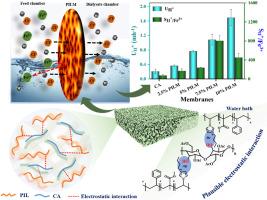Mechanism underlying anion-sieving in poly(ionic liquid)-based membrane: Effective acid recovery from engineering waste
IF 8.4
1区 工程技术
Q1 ENGINEERING, CHEMICAL
引用次数: 0
Abstract
Anion exchange membranes (AEMs) are promising for recovering acid from different engineering effluent due to their lower energy consumption, positive environmental impact, and potential for providing clean water resources. Utilizing the diffusion dialysis (DD) process, AEMs effectively retain metal ions while selectively allowing fast proton permeation. Achieving high hydrophilicity, proton conductivity, and ion exchange capacity through exact control of polymeric structure and chemical composition is crucial for enhancing the efficiency of the acid recovery process. This study presents the findings on the impact of novel Poly(ionic liquid) on cellulose acetate-based AEMs for acid recovery through DD application. In this study, interconnected nanochannel AEMs with high acid permeability are engineered using a straightforward blending technique. Poly(3-butyl-1-vinylimidazolium bromide-co-methyl methacrylate-co-styrene) (poly([BVIM]-[Br]–co–MMA-co-Styrene, PIL) is blended with cellulose acetate to achieve ionic crosslinking, resulting in a mechanically stable membrane. The dosage of PIL within the membrane matrix plays a vital role in determining the prepared membranes' physicochemical properties and ion exchange capabilities, which exhibit excellent thermal stability. Remarkably, the optimal AEM (7.5 % PILM) exhibits a high acid dialysis coefficient (UH+) of 1.05 m/h and a separation factor (S) of 802, outperforming previously reported state-of-the-art AEMs and commercial membranes. These findings indicate that the prepared AEMs are highly effective for acid recovery through DD. Notably, our work stands out by introducing new AEMs with superior acid dialysis performance and selectivity.

聚(离子液体)膜中的阴离子筛分机理:从工程废料中有效回收酸
阴离子交换膜(AEM)能耗较低、对环境有积极影响,而且具有提供清洁水资源的潜力,因此有望从不同的工程废水中回收酸。利用扩散透析(DD)工艺,阴离子交换膜可有效截留金属离子,同时选择性地允许质子快速渗透。通过精确控制聚合物结构和化学成分来实现高亲水性、质子传导性和离子交换能力,对于提高酸回收工艺的效率至关重要。本研究介绍了新型聚(离子液体)对醋酸纤维素基 AEMs 通过 DD 应用进行酸回收的影响。在这项研究中,采用一种简单的混合技术,设计出了具有高酸渗透性的互连纳米通道 AEM。聚(3-丁基-1-乙烯基溴化咪唑-甲基丙烯酸甲酯-苯乙烯)(Poly([BVIM]-[Br]-co-MMA-co-Styrene, PIL)与醋酸纤维素混合,实现离子交联,从而形成机械稳定的膜。膜基质中 PIL 的用量在决定制备的膜的理化性质和离子交换能力方面起着至关重要的作用,这种膜具有出色的热稳定性。值得注意的是,最佳 AEM(7.5% PILM)的酸透析系数(UH+)高达 1.05 m/h,分离因子(S)达 802,优于之前报道的最先进的 AEM 和商用膜。这些研究结果表明,所制备的 AEM 在通过 DD 进行酸回收方面非常有效。值得注意的是,我们的工作通过引入具有卓越酸透析性能和选择性的新型 AEM 而脱颖而出。
本文章由计算机程序翻译,如有差异,请以英文原文为准。
求助全文
约1分钟内获得全文
求助全文
来源期刊

Journal of Membrane Science
工程技术-高分子科学
CiteScore
17.10
自引率
17.90%
发文量
1031
审稿时长
2.5 months
期刊介绍:
The Journal of Membrane Science is a publication that focuses on membrane systems and is aimed at academic and industrial chemists, chemical engineers, materials scientists, and membranologists. It publishes original research and reviews on various aspects of membrane transport, membrane formation/structure, fouling, module/process design, and processes/applications. The journal primarily focuses on the structure, function, and performance of non-biological membranes but also includes papers that relate to biological membranes. The Journal of Membrane Science publishes Full Text Papers, State-of-the-Art Reviews, Letters to the Editor, and Perspectives.
 求助内容:
求助内容: 应助结果提醒方式:
应助结果提醒方式:


